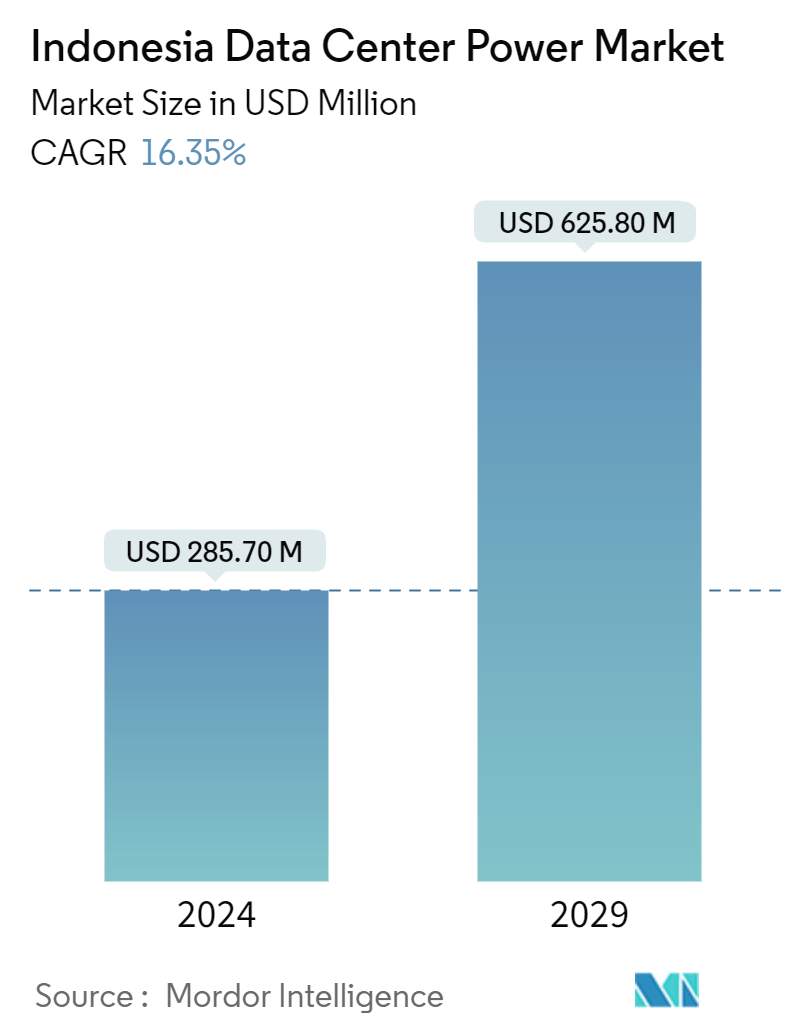Market Size of Indonesia Data Center Power Industry

| Study Period | 2018 - 2029 |
| Base Year For Estimation | 2023 |
| Market Size (2024) | USD 285.70 Million |
| Market Size (2029) | USD 625.80 Million |
| CAGR (2024 - 2029) | 16.35 % |
| Market Concentration | High |
Major Players
*Disclaimer: Major Players sorted in no particular order |
Indonesia Data Center Power Market Analysis
The Indonesia Data Center Power Market size is estimated at USD 285.70 million in 2024, and is expected to reach USD 625.80 million by 2029, growing at a CAGR of 16.35% during the forecast period (2024-2029).
The increasing demand for cloud computing among SMEs, government regulations for local data security, and growing investment by domestic players are some of the major factors driving the demand for data centers in the country.
- Under Construction IT Load Capacity: The upcoming IT load capacity of the Taiwanese data center market is expected to reach 1,205.3 MW by 2029.
- Under Construction Raised Floor Space: The country's construction of raised floor area is expected to increase to 4.37 million sq. ft by 2029.
- Planned Racks: The country's total number of racks to be installed is expected to reach 80,000 units by 2029. Greater Jakarta is expected to house the maximum number of racks by 2029.
- Planned Submarine Cables: There are close to 25 submarine cable systems connecting Indonesia, and many are under construction. One such submarine cable that is estimated to start service in 2024 is Apricot, which stretches over 11,972 km with landing points from Batam and Tanjung Pakis.
- The government considers power-saving measures such as subsidies to increase energy efficiency or productivity and moves towards a low-carbon system to solve the electricity problem and crisis. In support of the above policy and to reduce energy consumption, key market players are focusing on introducing efficient power management systems such as PDUs, busways, and UPS for the purpose of controlling unnecessary expenditures in data centers, which is expected to fuel market growth.
Indonesia Data Center Power Industry Segmentation
Data center power refers to the power infrastructure, including electrical components and electrical distribution systems, that provide the power necessary to operate and support the devices and servers within the data center. It includes various components and technologies designed to ensure a reliable, uninterruptible power supply for data center IT equipment, including uninterruptible power supplies (UPS), power distribution units (PDU), backup generators, and other power management solutions tailored to the specific needs of data centers. Data center operators achieve data center redundancy through duplicated components to maintain uninterrupted operations in the event of failure of some components and to maintain uptime during maintenance.
The Indonesian data center power market is segmented by power infrastructure (electrical solution {UPS systems, generators, power distribution solutions [PDU, switchgear, critical power distribution, transfer switches, remote power panels, and other power distribution solutions}, and service), end user (IT and telecommunication, BFSI, government, media and entertainment, and other end users). The market sizes and forecasts are provided in terms of value (USD) for all the above segments.
| By Power Infrastructure | ||||||||||||
| ||||||||||||
| Service |
| By End User | |
| IT and Telecommunication | |
| BFSI | |
| Government | |
| Media and Entertainment | |
| Other End Users |
Indonesia Data Center Power Market Size Summary
The Indonesian data center power market is experiencing significant growth, driven by the increasing demand for cloud computing, government regulations on data security, and substantial investments from domestic players. The market is characterized by a shift towards larger and more advanced data center infrastructures, such as massive and mega data centers, to meet the rising demand for digital storage and processing capabilities. This transition is supported by the construction of new facilities and the expansion of existing ones, particularly in Greater Jakarta. The focus on energy efficiency and power management systems, such as intelligent PDUs and UPS, is also contributing to the market's expansion, aligning with government initiatives to reduce electricity consumption and promote a low-carbon economy.
The competitive landscape of the Indonesian data center power market is marked by the presence of multiple vendors and intense competition, with key players like Schneider Electric, ABB, Rittal, Fujitsu, and Legrand actively participating. These companies are engaging in strategic initiatives, including mergers, acquisitions, and partnerships, to strengthen their market positions. The market is also witnessing technological advancements, such as the introduction of new power distribution systems and monitoring technologies, which are expected to drive further demand. Major projects, including those led by PT DCI Indonesia Tbk and other significant players, are underway, contributing to the market's robust growth trajectory over the forecast period.
Indonesia Data Center Power Market Size - Table of Contents
-
1. Market Dynamics
-
1.1 Market Overview
-
1.2 Market Drivers
-
1.2.1 Rising Adoption of Mega Data Centers and Cloud Computing
-
1.2.2 Increasing Demand to Reduce Operational Costs
-
-
1.3 Market Restraints
-
1.3.1 High Cost of Installation and Maintenance
-
-
1.4 Value Chain / Supply Chain Analysis
-
1.5 Industry Attractiveness - Porter's Five Forces Analysis
-
1.5.1 Threat of New Entrants
-
1.5.2 Bargaining Power of Buyers/Consumers
-
1.5.3 Bargaining Power of Suppliers
-
1.5.4 Threat of Substitute Products
-
1.5.5 Intensity of Competitive Rivalry
-
-
1.6 Assessment of COVID-19 Impact
-
-
2. MARKET SEGMENTATION
-
2.1 By Power Infrastructure
-
2.1.1 Electrical Solution
-
2.1.1.1 UPS Systems
-
2.1.1.2 Generators
-
2.1.1.3 Power Distribution Solutions
-
2.1.1.3.1 PDU
-
2.1.1.3.2 Switchgear
-
2.1.1.3.3 Critical Power Distribution
-
2.1.1.3.4 Transfer Switches
-
2.1.1.3.5 Remote Power Panels
-
2.1.1.3.6 Other Power Distribution Solutions
-
-
-
2.1.2 Service
-
-
2.2 By End User
-
2.2.1 IT and Telecommunication
-
2.2.2 BFSI
-
2.2.3 Government
-
2.2.4 Media and Entertainment
-
2.2.5 Other End Users
-
-
Indonesia Data Center Power Market Size FAQs
How big is the Indonesia Data Center Power Market?
The Indonesia Data Center Power Market size is expected to reach USD 285.70 million in 2024 and grow at a CAGR of 16.35% to reach USD 625.80 million by 2029.
What is the current Indonesia Data Center Power Market size?
In 2024, the Indonesia Data Center Power Market size is expected to reach USD 285.70 million.

